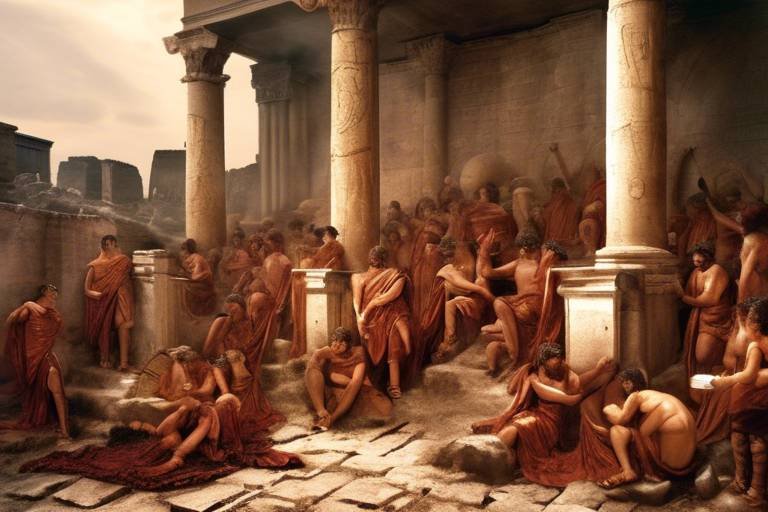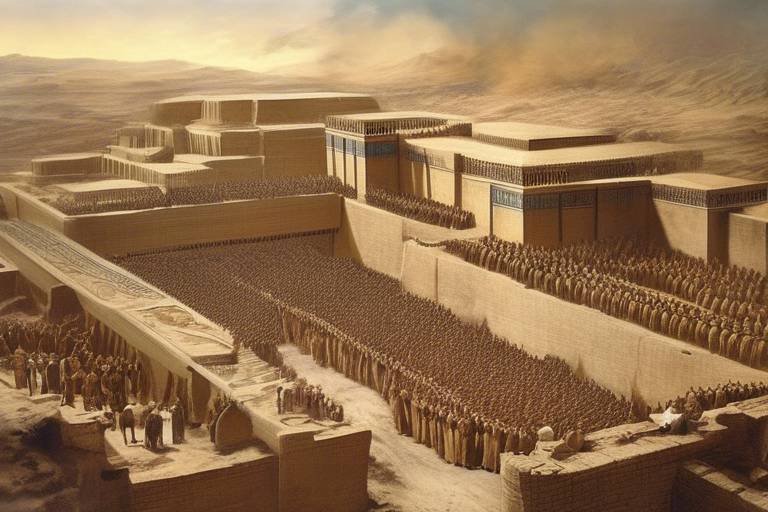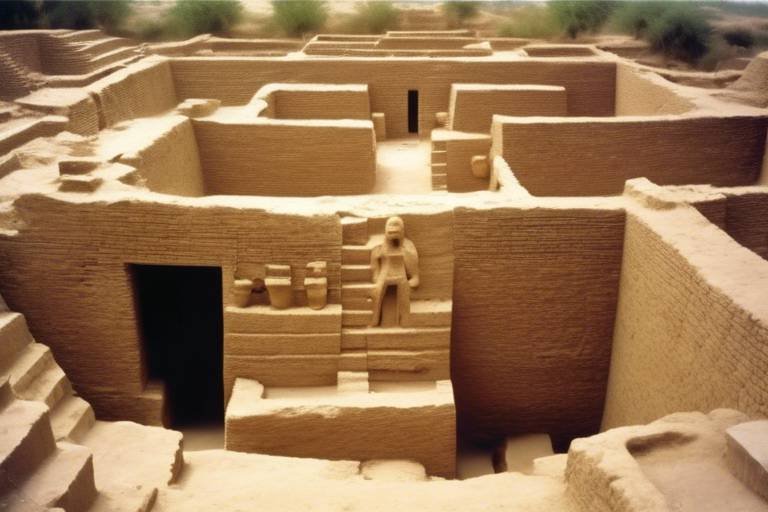The Cultural Richness of the Hellenistic Period
During the Hellenistic Period, a vibrant tapestry of cultural richness unfolded, leaving an indelible mark on history. This era, following the reign of Alexander the Great, witnessed a remarkable fusion of diverse cultural elements, giving rise to unprecedented advancements in art, philosophy, architecture, literature, and science.
Art flourished during this period, with artists blending Greek, Egyptian, and Eastern influences to create exquisite masterpieces in various forms such as sculpture, pottery, and painting. The art of the Hellenistic Period reflected a harmonious convergence of styles, resulting in visually stunning and emotionally evocative works that captivated audiences.
Philosophical thought thrived with the emergence of schools like Stoicism, Epicureanism, and Skepticism, which played a pivotal role in shaping ethical and moral beliefs in society. These philosophical movements offered profound insights into the nature of existence, human behavior, and the pursuit of wisdom and happiness.
The architectural marvels of the Hellenistic Period stand as enduring testaments to the innovative spirit of the time. From grand temples to majestic theaters and bustling cities, the architecture of this era combined Greek architectural principles with local styles, creating awe-inspiring structures that symbolized power, beauty, and cultural sophistication.
Literature also experienced a golden age during this period, producing timeless works such as epic poems like the Argonautica and the comedies of Menander. The richness and diversity of Hellenistic literature showcased the creativity and intellectual vitality of the era, captivating audiences with tales of heroism, love, and human folly.
Scientific progress flourished in fields like astronomy, mathematics, and medicine, with luminaries such as Euclid, Archimedes, and Hippocrates pushing the boundaries of knowledge and understanding. Their groundbreaking discoveries and innovations laid the foundation for future scientific advancements and revolutionized our understanding of the natural world.
Religious syncretism, a hallmark of the Hellenistic Period, witnessed the blending of deities and beliefs from different cultures, giving rise to new religious practices and cults. This cultural fusion not only enriched spiritual traditions but also fostered a sense of interconnectedness and mutual understanding among diverse communities.
Examining the social structures of Hellenistic kingdoms reveals a complex tapestry of societal norms, including the roles of women, the institution of slavery, and the dynamics between social classes. These structures shaped daily life, influencing relationships, power dynamics, and cultural practices within the diverse communities of the time.
The legacy of the Hellenistic Period endures as a testament to human ingenuity, creativity, and cultural exchange. Its profound influence reverberates through subsequent cultures and civilizations, leaving an indelible mark on the world's cultural heritage and inspiring generations to embrace diversity, innovation, and the pursuit of knowledge.

Artistic Achievements
Exploring the diverse and influential cultural developments that emerged during the Hellenistic Period after the death of Alexander the Great, including art, philosophy, architecture, literature, and scientific advancements.
During the Hellenistic Period, artistic expression reached new heights, with a fusion of Greek, Egyptian, and Eastern influences giving rise to unique and captivating masterpieces. Sculpture, pottery, and painting flourished, showcasing the creativity and skill of artists who pushed the boundaries of traditional art forms.

Philosophical Schools
During the Hellenistic Period, philosophical schools flourished, offering diverse perspectives on life, ethics, and the nature of reality. These schools, such as Stoicism, Epicureanism, and Skepticism, played a significant role in shaping the intellectual landscape of the time. Stoicism, founded by Zeno of Citium, emphasized the importance of virtue, self-control, and living in harmony with nature. Its teachings resonated with many, providing a practical guide to navigating the challenges of life.
Epicureanism, on the other hand, founded by Epicurus, focused on the pursuit of pleasure and the avoidance of pain as the highest good. However, this pleasure was not to be mistaken with hedonism but rather with the tranquility that comes from living a simple and virtuous life. The school promoted the idea of ataraxia, a state of inner peace and freedom from fear, as the ultimate goal of human existence.
Skepticism, championed by Pyrrho of Elis, took a different approach by questioning the possibility of attaining true knowledge. Skeptics believed that certainty was elusive and that one should suspend judgment on all matters, leading to a state of mental tranquility. This philosophical stance challenged dogmatic beliefs and encouraged critical thinking and open-mindedness.
Each of these philosophical schools offered a unique perspective on how to live a good life and navigate the complexities of the world. Their teachings not only influenced individuals but also had a profound impact on the ethical and moral fabric of society, shaping the cultural and intellectual climate of the Hellenistic Period.

Architectural Marvels
During the Hellenistic Period, architectural marvels emerged as a testament to the fusion of Greek architectural principles with local styles, resulting in grand and innovative structures that defined the era. The period witnessed the construction of magnificent temples, theaters, and cities that showcased the artistic and engineering prowess of the time.
One of the most notable architectural achievements of the Hellenistic Period was the development of the **Hellenistic temple**, characterized by its elaborate designs and monumental size. These temples, dedicated to various gods and goddesses, featured intricate sculptures and decorative elements that reflected the cultural diversity of the period.
Moreover, **theaters** became integral architectural features in Hellenistic cities, serving as venues for performances, festivals, and civic gatherings. These theaters, often built into hillsides for optimal acoustics, exemplified the importance of entertainment and communal activities in Hellenistic society.
The urban planning of **Hellenistic cities** also stood out for its innovative approach, combining Greek urban design principles with local traditions to create bustling centers of trade, culture, and governance. Cities like **Alexandria** in Egypt and **Antioch** in Syria became vibrant hubs of intellectual and commercial activity, showcasing the cosmopolitan nature of the Hellenistic world.
Furthermore, the **integration of different architectural styles** during this period resulted in eclectic and visually striking buildings that reflected the multicultural influences of the time. The blending of Greek, Egyptian, Persian, and other artistic traditions gave rise to a unique architectural aesthetic that set the Hellenistic Period apart from previous eras.
In conclusion, the architectural marvels of the Hellenistic Period not only exemplified the technical skill and creative vision of the builders but also served as lasting symbols of the cultural richness and diversity that defined the era.

Literary Contributions
Exploring the diverse and influential cultural developments that emerged during the Hellenistic Period after the death of Alexander the Great, including art, philosophy, architecture, literature, and scientific advancements.
Highlighting the evolution of art forms such as sculpture, pottery, and painting, showcasing the fusion of Greek, Egyptian, and Eastern influences in creating unique masterpieces.
Discussing the proliferation of philosophical schools like Stoicism, Epicureanism, and Skepticism, and their impact on shaping ethical and moral beliefs in society.
Examining the architectural innovations of the period, including the grandeur of Hellenistic temples, theaters, and cities, reflecting a blend of Greek and local styles.
Exploring the literary works produced during this era, from epic poems like the Argonautica to the comedies of Menander, showcasing the diversity and creativity of Hellenistic literature.
Investigating the scientific progress made in fields such as astronomy, mathematics, and medicine, with notable figures like Euclid, Archimedes, and Hippocrates leading the way.
Examining the phenomenon of religious syncretism during the Hellenistic Period, where deities and beliefs from various cultures merged to form new religious practices and cults.
Analyzing the societal structures and norms of Hellenistic kingdoms, including the role of women, slavery, and the interaction between different social classes in shaping daily life.
Reflecting on the enduring legacy of the Hellenistic Period, its impact on subsequent cultures and civilizations, and the lasting contributions it made to the world's cultural heritage.
The Hellenistic Period was a golden age for literature, with a flourishing of diverse literary genres and styles. Writers of this era produced works that continue to captivate readers today with their rich storytelling and profound insights.

Scientific Advancements
During the Hellenistic Period, a time of intellectual flourishing and exploration, significant advancements were made in various scientific fields, pushing the boundaries of knowledge and innovation. Prominent figures like Euclid, Archimedes, and Hippocrates played pivotal roles in revolutionizing the understanding of the natural world.
Euclid, known as the "Father of Geometry," made groundbreaking contributions to mathematics with his work "Elements," a comprehensive compilation of geometric principles and proofs that became a foundational text for centuries to come. His logical approach and systematic presentation of mathematical concepts laid the groundwork for future mathematical developments.
Archimedes, a brilliant mathematician, physicist, and engineer, made remarkable discoveries in mathematics and physics. He formulated principles of hydrostatics, invented the Archimedes screw for lifting water, and calculated an accurate approximation of pi. His innovative thinking and experimental methods exemplified the spirit of scientific inquiry during the Hellenistic era.
Hippocrates, often regarded as the "Father of Medicine," revolutionized the practice of healthcare by emphasizing observation, diagnosis, and ethical treatment of patients. The Hippocratic Oath, attributed to him, set ethical standards for medical practitioners and emphasized the importance of patient care and confidentiality. Hippocrates' holistic approach to medicine laid the foundation for modern medical ethics and practices.
Furthermore, advancements in astronomy during the Hellenistic Period led to significant progress in understanding celestial phenomena. Astronomers like Aristarchus of Samos proposed a heliocentric model of the solar system, challenging traditional geocentric views. The development of tools like the astrolabe and the discovery of astronomical principles paved the way for future astronomical discoveries and laid the groundwork for the scientific revolution in later centuries.

Religious Syncretism
During the Hellenistic Period, religious syncretism played a significant role in the cultural landscape, leading to the blending of deities and beliefs from various traditions. This phenomenon resulted in the creation of new religious practices and cults that incorporated elements from Greek, Egyptian, Persian, and other cultures. The interaction and exchange of religious ideas fostered a rich tapestry of beliefs, rituals, and mythologies that influenced the spiritual life of the Hellenistic world.
One notable example of religious syncretism is the spread of the cult of Serapis, a deity that combined aspects of Egyptian Osiris and Apis with Greek Zeus and Hades. This fusion of diverse religious elements symbolized the interconnectedness of different cultures and the willingness to adapt and integrate beliefs to form a cohesive religious identity.
Moreover, the Hellenistic rulers actively promoted syncretic practices to unify their diverse subjects under a common religious framework. The blending of local traditions with Greek religious concepts not only facilitated cultural exchange but also contributed to the formation of hybrid religious expressions that resonated with the multicultural population of the Hellenistic world.
Religious syncretism also influenced artistic representations, as seen in the iconography of deities like Isis and Serapis, which combined attributes from various traditions to appeal to a wider audience. The syncretic nature of Hellenistic religion reflected the interconnectedness of the ancient world and the fluidity of religious boundaries that allowed for the coexistence of diverse beliefs and practices.

Social Structures
During the Hellenistic Period, the social structures of the kingdoms reflected a complex tapestry of interactions and hierarchies. The role of women in society varied across different regions, with some enjoying more freedom and participation in public life, while others were confined to traditional domestic roles. Slavery was a prevalent institution, with slaves forming a significant part of the labor force and household staff in many households.
The interaction between different social classes was marked by distinct divisions and hierarchies. The elite class, comprising aristocrats and wealthy landowners, held significant political and economic power, shaping the direction of society. The middle class, including merchants and artisans, contributed to the economy and cultural life of the cities. Meanwhile, the lower class, consisting of laborers and the poor, faced challenges in accessing resources and opportunities.
Despite these social divisions, the Hellenistic Period also witnessed moments of social mobility and interaction between classes. The urban centers served as melting pots of diverse cultures and backgrounds, fostering exchanges of ideas and practices among people from various walks of life. Festivals, theaters, and public spaces provided avenues for social gatherings and community engagement, bridging the gaps between different social strata.
Moreover, the patronage system played a crucial role in shaping social structures, with wealthy individuals supporting artists, philosophers, and scholars, contributing to the flourishing of cultural and intellectual life. This system of patronage created networks of influence and collaboration, allowing individuals from different social backgrounds to connect and create lasting legacies in art, philosophy, and science.

Legacy and Influence
As we reflect on the legacy and influence of the Hellenistic Period, it becomes evident that this era left an indelible mark on the course of history. The cultural richness and intellectual achievements of this period continue to inspire and influence modern society in profound ways. From art and philosophy to architecture and science, the Hellenistic Period set the stage for a new wave of creativity and innovation that reverberated through the ages.
One of the most enduring legacies of the Hellenistic Period is its artistic achievements. The fusion of Greek, Egyptian, and Eastern influences gave rise to unique masterpieces in sculpture, pottery, and painting. These art forms not only captivated the eye but also served as a testament to the cultural diversity and creativity of the time. The Hellenistic artistry set a standard of excellence that continues to be admired and emulated to this day.
Furthermore, the philosophical schools that flourished during this period, such as Stoicism, Epicureanism, and Skepticism, laid the groundwork for ethical and moral beliefs that still resonate in contemporary thought. The profound insights and teachings of these philosophers have shaped the way we perceive the world and our place in it, fostering a deeper understanding of human nature and the pursuit of wisdom.
Architecturally, the Hellenistic Period introduced marvels that showcased the grandeur and innovation of the time. The temples, theaters, and cities built during this era reflected a harmonious blend of Greek architectural principles with local styles, creating structures that stood as testaments to human ingenuity and engineering prowess. These architectural marvels continue to awe and inspire architects and historians alike.
In the realm of literature, the Hellenistic Period produced a rich tapestry of literary works that ranged from epic poems like the Argonautica to the comedies of Menander. These literary contributions not only entertained audiences but also provided insights into the social and cultural dynamics of the time. The diversity and creativity of Hellenistic literature continue to be celebrated for their enduring relevance and artistic merit.
Moreover, the scientific advancements made during the Hellenistic Period, particularly in fields such as astronomy, mathematics, and medicine, propelled humanity towards new frontiers of knowledge and understanding. Figures like Euclid, Archimedes, and Hippocrates revolutionized their respective disciplines, laying the foundation for future scientific inquiry and discovery.
The phenomenon of religious syncretism that characterized the Hellenistic Period also left a lasting impact on religious practices and beliefs. The merging of deities and rituals from different cultures gave rise to new religious practices and cults, fostering a sense of spiritual unity and diversity that transcended traditional boundaries.
When we consider the social structures of Hellenistic kingdoms, we gain insight into the complexities of daily life during this period. The roles of women, the institution of slavery, and the interactions between different social classes all played pivotal roles in shaping the fabric of society. These social dynamics continue to inform our understanding of historical civilizations and the complexities of human relationships.
In conclusion, the legacy and influence of the Hellenistic Period endure as a testament to the enduring power of human creativity, intellect, and innovation. The cultural richness and intellectual achievements of this era continue to inspire and shape our world, reminding us of the profound impact that past civilizations have on our present and future.
Frequently Asked Questions
- What is the significance of the Hellenistic Period in history?
The Hellenistic Period marked a time of significant cultural fusion and innovation following the conquests of Alexander the Great. It brought together diverse influences from Greek, Egyptian, and Eastern civilizations, leading to advancements in art, philosophy, science, and more.
- How did the artistic achievements of the Hellenistic Period differ from earlier Greek art?
Hellenistic art showcased a departure from the idealized forms of Classical Greek art, embracing more realistic and emotional portrayals. Sculptures became more dynamic, capturing movement and expression, while also incorporating influences from other cultures.
- What were some of the major philosophical schools that emerged during the Hellenistic Period?
Philosophical schools such as Stoicism, Epicureanism, and Skepticism gained prominence during this era. Stoicism focused on ethics and self-control, Epicureanism emphasized pleasure and tranquility, while Skepticism questioned the possibility of attaining true knowledge.
- How did religious syncretism impact the Hellenistic world?
Religious syncretism in the Hellenistic Period led to the blending of deities and beliefs from various cultures, resulting in new religious practices and cults. This phenomenon reflected the interconnected nature of the ancient world and influenced the development of belief systems.



















